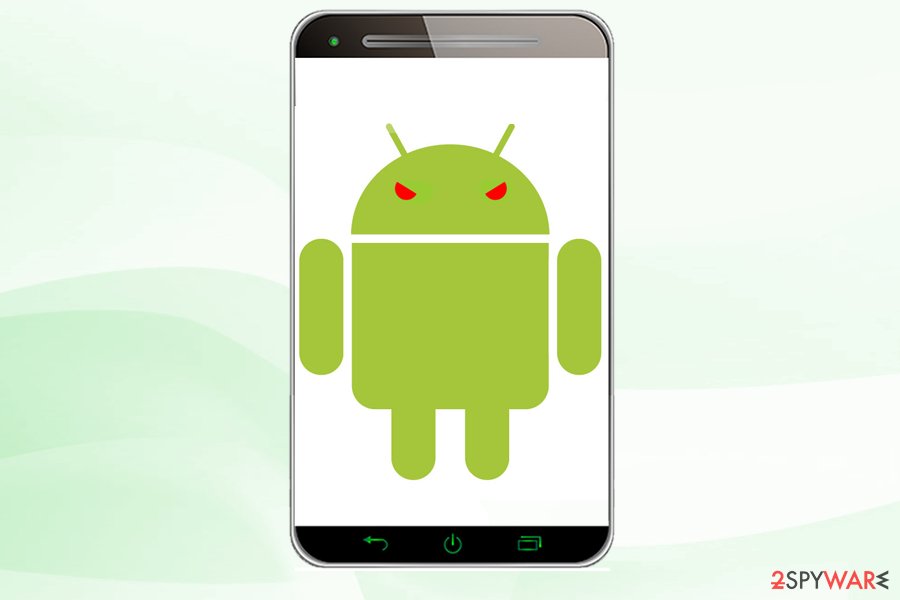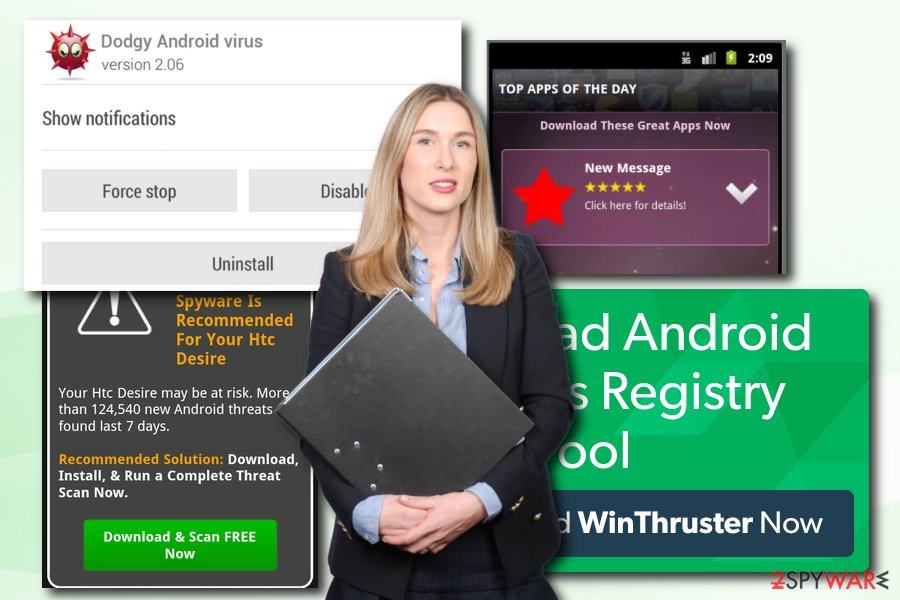Com.system.update is a fraudulent app that shows undesired advertisements on your Android device


Com.system.update is a malicious domain that shows users unending ads, redirects them to questionable realms, displays bogus pop-ups about the supposedly outdated Android device, or shows fake security warnings. These type of disturbances are typically caused by an adware[1] program that got into your machine without you noticing.
Com.system.update has stopped pop-up is the one that shows up screens and frustrates people about questionable source and application that is reportedly not working or triggering the issues, int e first place.[2] Thi malware can run and trigger serious corruption if you do not pay attention or clear the infection fully in time.
We recommend finding ways to remove Com.system.update as soon as possible. You need to clear disabled, possibly malicious apps, and anything that is suspicious or can trigger problems with the performance. Clear such programs and affected files automatically with proper optimizers or try to follow factory reset steps below.
| SUMMARY | |
| Name | Com.system.update |
|---|---|
| Type | Adware/ Android virus |
| Devices affected | Android tablets and phones |
| Effects | Intrusive advertisements, redirects, the slowdown of the device operation, etc. |
| Distribution | Third-party app sites, unknown web sites, software bundling |
Adware is a relatively harmless piece of software that is created to expose users to an excessive advertisement in the form of pop-ups, deals, banners, coupons, offers, and similar. These ads are generated whenever users browse the internet via Google Chrome, Internet Explorer, Firefox, or other browsers.
Com.system.update android virus generates ads to boost the traffic of less known domains and increase their sales. This way, developers of adware benefit financially for even click made – even an accidental ones. Thus, it is in the authors’ best interest to get as many clicks as possible.
Unfortunately, Com.system.update creators do not check the content they are redirecting users to. Thus, the content might sometimes be appealing (as well as legitimate), but other times it can be dangerous, leading to porn, fake software, fake update, illegal or even malware-ridden websites. To avoid that, remove Com.system.update virus from your Android using Reimage Reimage Cleaner Intego.
Adware multiplies quickly and can result in deterioration of the system performance of your tablet or mobile phone. If Com.system.update virus is not removed from the device soon, it will result in slow loading times of web pages, multiple error messages, slow boot up or shut down. Thus, using your Android device might become a total nightmare.
In addition to Com.system.update advertising tendencies, the adware spies on each of the users that are using the malicious app. Typically, the ad-supported software collects a variety of non-personally identifiable information about users. This is done to monitor their behavior online and display targeted advertisements.
The collected data might include:
- IP address;
- Geo-location;
- Browser used;
- Installed apps;
- Search queries;
- Websites visited, etc.
Additionally, Com.system.update might also collect personal information[3] that you enter on dodgy websites. Therefore, if you clicked on a shady add or got redirected to a suspicious realm, do not interact with it in any way! Simply close down your browser and proceed with Com.system.update removal. We explain the procedure below this article.

Com.system.update pop-ups are caused by adware program installed on Android device

Com.system.update pop-ups are caused by adware program installed on Android device
Ways you can avoid unwanted applications on your device
Adware programs are typically not installed intentionally. Therefore, it is essential to be vigilant while installing new apps or browsing the internet on your device. Security experts[4] advise to never use third-party sources for new apps. Instead, it is recommended to pick trusted sources, such as Google Play Store.
Nevertheless, some of the applications on Google Play, Amazon, or another legitimate source might also contain malicious code. It does not happen often; however, some of the dubious apps can even get past Google’s security checks. Thus, we advise users to read reviews before downloading the new app and never pick one with very few downloads.
Additionally, we advise users to be careful while browsing the internet. We suggest avoiding websites of suspicious content. These pop-ups can show up in relation to other programs or cyber intruders and trigger permanent damage, other issues on the machine.
Com.system.update removal procedure
There is no doubt that you should remove Com.system.update the virus as soon as possible. This way you can avoid such dangers as stolen personal information or infiltration of other unwanted apps/viruses.
To make sure that your device is not infected with malware, you should scan it with an anti-malware tool or other reputable security software. Such tools should have compatible programs with your OS. Try SpyHunter 5Combo Cleaner or Malwarebytes for the Com.system.update removal.
Before you can eliminate the threat, you need to boot your device in Safe Mode. To secure safe operation, proceed with the following Com.system.update removal steps:
- The Press Power button on your phone/tablet and hold it. The pop-up window will appear – click on Reboot
- As soon as startup animation starts, press and hold Volume Down button – you will be able to enter Safe Mode
- Next, go to Settings and click Apps
- Go through the list of all applications and check for anything suspicious. Click on the undesired app and press Uninstall
Tip: never give administration rights to any app. If you do, it will gain removal protection, and it will be extremely complicated to eliminate.
Online spying has got momentum in recent years and people are getting more and more interested in how to protect their privacy online. One of the basic means to add a layer of security – choose the most private and secure web browser. Although web browsers can’t grant a full privacy protection and security, some of them are much better at sandboxing, HTTPS upgrading, active content blocking, tracking blocking, phishing protection, and similar privacy-oriented features.
Nevertheless, there’s a way to add an extra layer of protection and create a completely anonymous web browsing practice with the help of Private Internet Access VPN. This software reroutes traffic through different servers, thus leaving your IP address and geolocation in disguise. Besides, it is based on a strict no-log policy, meaning that no data will be recorded, leaked, and available for both first and third parties. The combination of a secure web browser and Private Internet Access VPN will let you browse the Internet without a feeling of being spied or targeted by criminals.
While much of the data can be accidentally deleted due to various circumstances, malware is also one of the main culprits that can cause loss of pictures, documents, videos, and other important files. Potentially unwanted programs may clear files that keep the application from running smoothly.
More serious malware infections lead to significant data loss when your documents, system files, or images get locked. Ransomware is the one that is focused on such functions, so your device gets useless without access to needed data. Even though there is little to no possibility to recover after file-locking threats, some applications have features for such recovery in the system.
In some cases, Data Recovery Pro can also help to recover at least some portion of your data after data-locking virus infection or general cyber infection.

